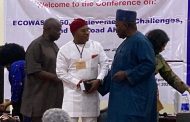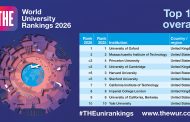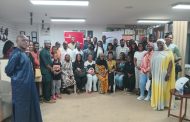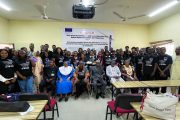
The author
By Gregory Elich
This week’s edition of Pambazuka Online is a loaded one, devoted almost entirely to Zimbabwe. This piece, for example, has been written by someone who, by the introduction below, is well situated to have written this way. Originally published as “What is Behind the Military Coup in Zimbabwe?” in two other outlets before Pambazuka, it is, indeed, explosive. The references have been edited out because they add very little to a non-academic reader of the piece. Enjoy it – Editor
Long-roiling factional conflict within Zimbabwe’s ruling ZANU-PF political party exploded last week in a military coup that quickly seized control of the government and state media. The coup was led by Commander of Zimbabwe Defense Forces Constantino Chiwenga, who is closely aligned with former vice president Emmerson Mnangagwa.
Emboldened by President Robert Mugabe’s declining mental sharpness and physical health in recent years, Mnangagwa actively manoeuvred to ensure that he would succeed the president. Mnangagwa served as one of Zimbabwe’s two vice presidents. From that position, he and his supporters, known as Team Lacoste, became embroiled in a bitter struggle with younger party members who coalesced around Secretary of Women’s Affairs Grace Mugabe, wife of the president, and whose group was known as Generation 40, or G40.
As early as 2015, Mnangagwa began reaching out to opposition leader Morgan Tsvangirai to discuss plans to implement a five-year transition government, in which both men would play a leading role. The unity government would compensate and “reintegrate” dispossessed former owners of large-scale farms. Reuters obtained hundreds of internal documents from Zimbabwe’s Central Intelligence Organization that revealed the plan. “Key aspects of the transition planning described in the documents were corroborated by interviews with political, diplomatic and intelligence sources in Zimbabwe and South Africa,” reports Reuters. The same sources left open “the possibility that the government could be unelected.” In one report, it was said that Mugabe feared that Mnangagwa would attempt to reverse land reform. [1]
According to the documents, senior military officials met with Tsvangirai, many of whom were “saying it is better to clandestinely rally behind Tsvangirai for a change.” Security officials also secretly met with Mnangagwa to discuss Mugabe. “They all agree that Mugabe is now a security threat due to his ill health.” Not surprisingly, “four people with direct knowledge of coalition-related discussions about post-Mugabe rebuilding” indicated that Great Britain had at least peripheral involvement in discussions, and British ambassador to Zimbabwe Catriona Laing was said to favor “Mnangagwa to succeed Mugabe.” [2]
Such behind the scenes machinations did not sit well with G40, and mutual recrimination escalated between Team Lacoste and G40 in recent months. In an explosive politburo meeting on July 19, Minister of Higher Education Jonathan Moyo played a damning video that exposed Mnangagwa’s plans. The video accused him of “working to systematically undermine President Robert Mugabe by capturing the party and state institutions.” The video also revealed that General Chiwenga was deeply involved in those plans. Audio recordings of Zimpapers journalists stated that “they are working to further VP Mnangagwa’s succession agenda and that they work closely with General Chiwenga.” [3]
The video claimed that Mnangagwa’s allies in government were using their positions “to advance his bid to unconstitutionally and criminally succeed President Mugabe…The objective was to seize control of the party. That scheme is outlined and detailed in a secessionist strategy document that was published in 2015 entitled Blue Ocean.” Quoting the Blue Ocean Strategy document, the video said: “Critical positions must be secured in these institutions and the personnel must be given instructions to hoard dossiers on the G40 brass and all echelons of the party.” [4]
The Blue Ocean Strategy sought to use the dossiers “to make it toxic for anyone to be associated with the G40 group.” Other tactics included attacks on the character of G40 members, and infiltrating the group and creating discord. “Seeds of distrust must be sown in that alliance with the First Lady with immediate effect,” the document urged. [5] The campaign to discredit G40 was intended to clear the path to power for Mnangagwa.
By marshalling an impressive array of evidence, the video made a persuasive case, which the military coup on Mnangagwa’s behalf has amply confirmed.

Mugabe with the two Vice-Presidents, Mnangagwa and Phelekezela Mphoko, (right) before the crack
Mnangagwa did not react with equanimity to the video. Moyo says that he responded to the presentation by “making a shocking statement to the effect that while he was in Mozambique, during the liberation struggle, people who made interventions such as my presentation to the Politburo on 19 July would have ‘their head separated from their shoulders’.” The effect of Mnangagwa’s statement, Moyo continued, “was to threaten me with murder.” [6]
Given the opportunity to answer Moyo’s charges, Mnangagwa delivered an 85-page report to President Mugabe in September. Mnangagwa claimed he was loyal, and without providing evidence, accused Moyo of being a CIA agent and that along with his cohorts in G40, was plotting against Mugabe. Mnangagwa asserted that Moyo was spreading falsehoods about an impending coup. “Professor Moyo concocted a story that his cousin Major Nkosana Moyo who is with the Presidential Guard informed you of a planned coup by the army and [to] install me as the country’s new leader.” [7] Moyo’s warning had been no falsehood.
On October 11, Mnangagwa went on the counterattack in a formal presentation at a politburo meeting. He repeated the allegation that Moyo was a CIA spy, which he asserted the U.S. Embassy in Harare had confirmed — as if the CIA is in the habit of announcing who its spies are. Mnangagwa pointed to Wikileaks documents concerning discussions Moyo held with U.S. officials during the years when Moyo was not a member of ZANU-PF. An official who attended the politburo meeting reported that Mnangagwa “said the whole army was loyal and played two video clips of General Chiwenga pledging loyalty to the national political leadership.” [8]
Mnangagwa accused Moyo of “harbor[ing] an agenda of destroying the party whether from within…or otherwise.” As proof of that intent, he quoted Moyo as having said, “Now, if your uneducated mind translates reform as destruction, to hell with you. That is not my problem, and I want to repeat that very statement that the best way to reform ZANU-PF is from within.” It is odd that Mnangagwa would be so uncomprehending as to choose such a statement to bolster his claim that Moyo was out to destroy the party. Mnangagwa added that he has “been trying to understand how a party as solid as ZANU-PF can at any given time be said to be in need of reform.” [9]
The bulk of the speech was devoted to quoting Moyo from his years outside the party, when he made some critical remarks, and which Moyo has never denied. Mnangagwa argued that Moyo “deceived” the Central Intelligence Organization into telling President Mugabe that “the army wanted to commit a coup,” and that Moyo “knows truly well that all these are lies and fabrications.”
Member of Parliament Shadreck Mashayamombe, Mnangagwa continued, unjustly claimed that the army would carry out a coup “in a brazen and bizarre attempt to tarnish my name. What has happened since then? Why should people believe your coup claims now when you have lied about that before?” [10] How different those questions look now!
In his response, Moyo pointed out that Mnangagwa had failed to address any of the issues he had raised in his earlier presentation concerning Mnangagwa’s plan to topple the government. Regarding Wikileaks documents, Moyo pointed out that there are many more documents referring to Mnangagwa than him. Furthermore, unlike Mnangagwa, Moyo never met a foreign official while he was in government without the presence of foreign ministry officials. [11]
Moyo revealed that when he was an independent candidate in the 2005 election, Mnangagwa helped fund him and other opposition candidates. Indeed, it was Mnangagwa who led the establishment of the short-lived United People’s Movement. “Throughout the planning process, we had several strategizing meetings…but you have not owned up to that. Instead, you have given a presentation that presents you as ‘comrade loyal’ when that is far from the truth.” [12]
The evidence for Mnangagwa’s perfidy was too abundant to ignore, and on November 9 he was expelled from ZANU-PF and removed from his position as one of Zimbabwe’s two vice presidents. Minister of Local Government, Public Works and National Housing Saviour Kasukuwere submitted a report to the politburo which listed other members of the plot to overthrow the government. [13]
Soon thereafter, Mnangagwa turned up in South Africa and issued a statement threatening that President Mugabe and those around him would be driven from the party “in the coming few weeks.” Ominously, he added that his supporters “will very soon control the levers of power” and he “shall return to Zimbabwe to lead you.” [14]
Zimbabwe security forces went on high alert following Mnangagwa’s threats. A source close to Mnangagwa said, “This is no longer a game, gloves are now off, and I can tell you he will be back as promised. He arrived in China [to join General Chiwenga during his visit] where he will meet key contacts.” [15]
General Chiwenga issued a statement condemning Mnangagwa’s opponents and warning darkly that due to political instability, “the military will not hesitate to step in.” ZANU-PF chairman Simon Khaya-Moyo responded by saying the statement suggested “treasonable conduct” and “was meant to incite insurrection and violent challenge to the constitutional order.” [16]
The cause of Zimbabwe’s current predicament, Western media inform us, is a simple one. President Mugabe’s wife harbored political ambitions to one day assume the highest office in the land. There is nothing else that one needs to know. Let us leave aside the temptation to wonder why mainstream media, with its near universal adoration of former president Bill Clinton’s wife for her political ambitions, somehow find it reprehensible for a strong black woman in a similar relationship to have political aspirations.
For her part, Grace Mugabe has sent mixed signals on succession, so it is unclear what her exact thoughts were on the matter. [17] What is certain is that President Mugabe blundered in not arranging an orderly transition to a successor while he was in a stronger political position, and that failure left the door open for schemers like Mnangagwa and Chiwenga.
The reality is that Grace Mugabe’s political base was too narrow and she was too unpopular for there ever have been a chance of her winning an election. Much of what support she did have would have evaporated upon President Mugabe’s demise. It is not even clear that Grace Mugabe had any chance of being named to take Mnangagwa’s place as vice president. It would be up to the upcoming party congress in December to choose the vice president, President Mugabe announced. [18] Furthermore, many reports indicate that President Mugabe favored Defense Minister Sydney Sekeramayi as his successor. [19] President Mugabe was well aware of his wife’s lack of widespread support and that her candidacy in a presidential election would be political suicide for ZANU-PF, in that she would be a rallying point for the opposition. [20]

Gen Chiwenga, the out-going 10-day Head of State of Zimbabwe
General Chiwenga did not wait long to make good on his threat to launch a military coup. The government attempted to snuff out the rebellion before it started and dispatched a police paramilitary unit to the airport to arrest General Chiwenga upon his return from China. However, military intelligence caught wind of the plan and an army unit blocked the attempt, allowing Chiwenga to evade arrest. According to an official with knowledge of the incident, “When Chiwenga came, a team of soldiers dressed in National Handling Services (NHS) uniforms got inside the airport, while police positioned themselves to seize him. The soldiers reacted and disarmed them. The soldiers took off the NHS uniforms, revealing their camouflage fatigues, resulting in the police fleeing.” The army immediately set its long-planned coup in motion on the night of November 14-15, eliminating opposition by attacking policemen at the Parliament building and seizing the police paramilitary camp and armory. [21]
Armored vehicles and tanks rolled through Harare, taking control of key points. Gunfire was heard throughout the city, as the military hunted down and arrested every Mugabe supporter and member of G40 it could lay its hands on, not shying from the use of violence. According to one source, “The first casualty of the operation was Mugabe’s head of security,” Albert Ngulube. “He was grabbed right at Mugabe’s gate and taken to detention where he was brutally beaten.” Another source reported that soldiers took Ngulube’s “cellphone, watch and gold chain and later detained and interrogated him. He was heavily battered. He has some cracks on his head and could have died.” [22]
As one source reported, “Troops arrived at Kasukuwere’s house and shot their way into the residence before shelling it from about ten minutes…The families then escaped to Mugabe’s house…Moyo’s house was also stormed by soldiers.” Secretary of Youth Affairs Kudzai Chipanga and his wife were forced to strip naked and sit on the floor at a police station, where he was ordered to repeat the criticisms he had publicly made of General Chiwenga. Then he was severely beaten. The military later forced him to appear on television and apologize for having denounced Chiwenga’s threat to carry out a coup. [23]
Two Canadian journalists were falsely accused of working for the Central Intelligence Organization, and told by soldiers to lie on the ground. One of the journalists says, “And then they started beating us up. Anything that they had, with sticks, butt sticks, and at times they were using the guns that they had and someone was even saying ‘Hey, you can shoot them’.” Soldiers also walked on the journalists and the beatings lasted 15 to 20 minutes. [24]
When an army unit attacked the home of finance minister Ignatius Chombo, it shot dead his three guards. [25] Social media rumored that $10 million had been found in his home, but the photos posted proved to be disinformation. One photo was actually taken in Nigeria and the second photo in a police raid in Brazil. As one wag tweeted, juxtaposing a photo of the Brazil stash with the same photo identified as Chombo’s home, “Boxes of cash on the left were first found by police at apartment in Salvador, Brazil in September. Last night, same bags were found at house of Zimbabwe Finance Minister by the army.” [26]
“Basically, there is no government in Zimbabwe,” said an inside source. “Cabinet failed to seat on Tuesday because all ministers chose to stay away, fearing for their lives.” Among those who were arrested was Masvingo provincial minister Paul Chimedza, who failed in his attempt to flee the wave of repression sweeping the nation. [27]
The long-planned coup to install Mnangagwa was underway, but it was important for the military to present a façade of legality to appease the African Union. Enormous pressure was applied on President Mugabe to resign and appoint Mnangagwa as vice president. That would allow Mnangagwa to take over the reins of power in a legal manner. President Mugabe refused to buckle under intimidation, describing the coup as illegal – which, indeed, it was.
Opposition backers predominate in the cities, whereas Mugabe’s support is heavily concentrated in rural areas, where it can have little political effect. Western media portray the demonstration that was held in Harare to celebrate the coup as expressing the united voice of the people. All Zimbabweans, we were told, are happy at the turn of events. The demonstration represented the opinion of some people, but in what nation is there a monolithic political view? It is interesting how demonstrations only represent the “will of the people” when the cause is to the liking of Western elites. That said, economic difficulties – not entirely unrelated to Western sanctions – have contributed significantly to political dissatisfaction.
War Veterans’ chairman Chris Mutsvangwa, an ardent Mnangagwa supporter, revealed that the Army had capitalized on the Harare demonstration in an ugly bid to threaten Mugabe into capitulating. “The army gave the dictator a message earlier,” he said. “Either he steps down, or they will let the people into his mansion to take him. The army is threatening to unleash the people and let Mugabe be lynched. The generals said they will not shoot the people for him. Instead, they will abandon their posts and leave him to his fate.” [28]
The army was eager to install Mnangagwa as president, and Mugabe was not playing ball. The coup had long been in preparation, and as a leading opposition figure divulged, “a lot of talking was going on” between the army and “different factions to discuss the formation of a transitional government.” Discussions between the army and the opposition had been underway over the last several months. [29]
According to a member of the opposition Movement for Democratic Change (MDC), the plan by the army to bring the opposition into the government was “a done deal,” and was said to have “tacit agreement from regional powers.” [30]
Following the coup, Mnangagwa returned to Zimbabwe and began preparing to establish a transitional government that he would lead. It appears that South Africa may be playing some sort of role behind the scenes, as one source hinted. “The parties have been asked to prepare position papers ahead of the visit by [South African President Jacob] Zuma’s envoy. [MDC leader] Morgan Tsvangirai will present on behalf of his coalition, while [People’s Rainbow Alliance leader Joice] Mujuru will present on behalf of her coalition.” [31]
On Sunday, in the absence of Robert Mugabe’s supporters, ZANU-PF voted to expel the president from the party, and in his place appointed Emmerson Mnangagwa as head of the party. Mnangagwa and his backers were out for vengeance, and ZANU-PF announced that Grace Mugabe and G40 members would be prosecuted. [32] That still left the coup leaders without the means of “legally” installing Mnangagwa in power, so Mugabe was given a deadline of 24 hours to resign, or he would face impeachment on Tuesday. [33]
Western officials are keen to see the transitional government adopt economic policies to their liking. “It’s a transition to a new era for Zimbabwe; that’s really what we’re hoping for,” acting U.S. Assistant Secretary of State for African Affairs Donald Yamamoto said. [34] A European Union spokesperson announced that the EU is “committed to support Zimbabwe in the preparation of credible elections and the delivery of political and economic reforms.” [35]It can be expected that it will not be long before Western economic advisors are paying visits to the transitional government, urging it to enact reforms to liberalize the economy to suit Western investors.
* GREGORY ELICH is on the Board of Directors of the Jasenovac Research Institute and the Advisory Board of the Korea Policy Institute. He is a member of the Solidarity Committee for Democracy and Peace in Korea, a columnist for Voice of the People, and one of the co-authors of Killing Democracy: CIA and Pentagon Operations in the Post-Soviet Period, published in the Russian language. He is also a member of the Task Force to Stop THAAD in Korea and Militarism in Asia and the Pacific. His website ishttps://gregoryelich.org Follow him on Twitter at @GregoryElich. This article was originally published on Global Research and Counterpunch




























